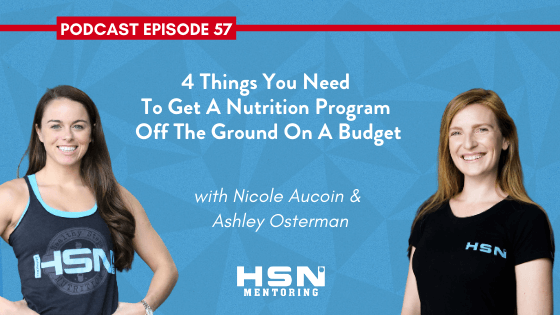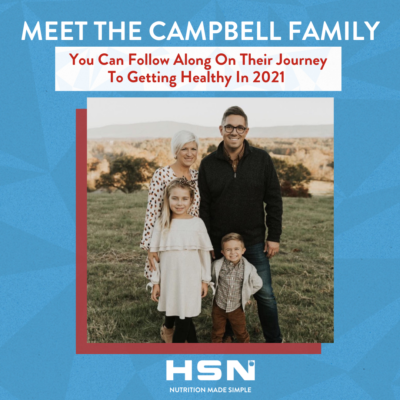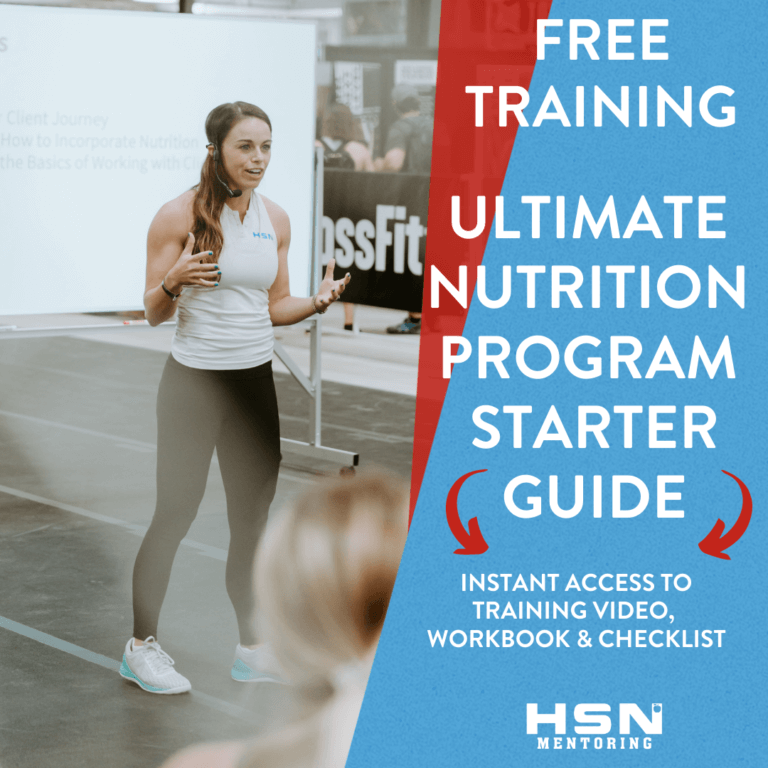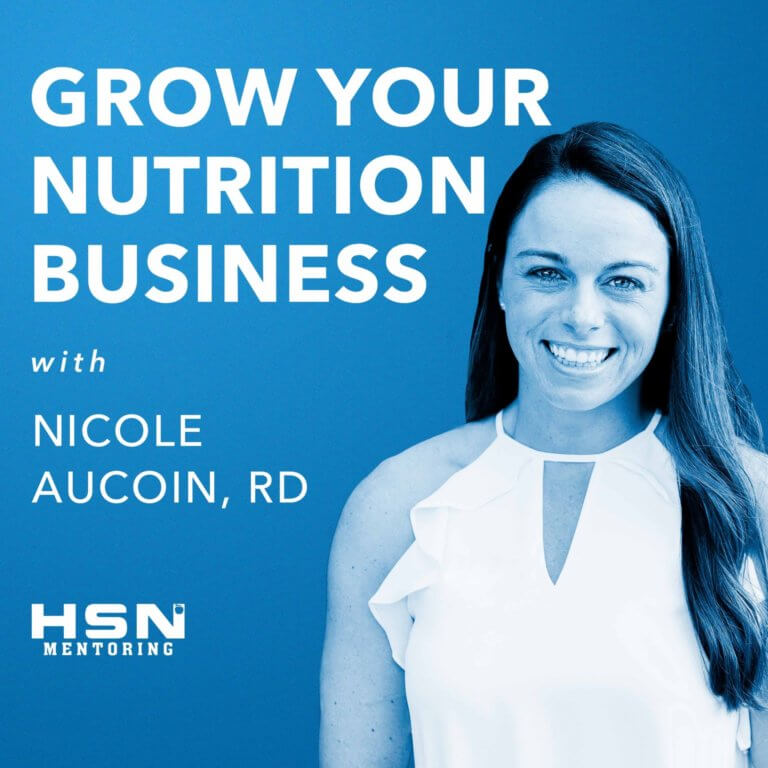Are you looking to get a nutrition program off the ground on a budget?
This week on the podcast, Ashley Osterman and Nicole Aucoin discuss four things that you need to get a nutrition program off the ground on a budget and exactly what we recommend. We’ve consolidated everything that you need to get a program off the ground and all the podcast episodes to get you started; just click the link in the show notes!
PS- Don’t forget to subscribe, so you catch every episode!
4 Things You Need To Get Your Nutrition Program Off The Ground On A Budget
Biometrics Testing
When working with nutrition clients, you need to be able to track their progress. At Healthy Steps Nutrition & HSN Mentoring, recommend testing weight, body fat, muscle mass and inches (using a tape measure).
You will want something in-house to test your client’s biometrics. The gold standard for biometric testing is an Inbody, but you don’t need a $6,000 machine to run a successful nutrition program. InBody has a home version on amazon for $300-$350.
You don’t want your clients to use one type of machine during a challenge then a different machine after the challenge is over.
Scheduling Software
You need an easy way for clients to schedule without the back and forth via email.
At Healthy Steps Nutrition & HSN Mentoring, we recommend using acuity scheduling. It is FREE for one calendar (solo nutrition coaches).
Member Management Software
In previous podcast episodes, we’ve talked about the importance of setting up nutrition memberships so that you don’t have to resell your clients on nutrition services during every appointment.
At Healthy Steps Nutrition, PushPress is our preferred partner for member management. You can set up a FREE account and start collecting payments from clients automatically.
Best of all, HSN has an integration with PushPress to make it easy to track your nutrition metrics like new clients, ongoing clients, nutrition-only revenue, hybrid revenue and churn rate.
Professional Email
When starting a business, you do not want to use your personal email. Through gmail and g-suite, you can set up a professional email connected to your website domain. For instance, at Healthy Steps Nutrition HQ, our domain is healthystepsnutrition.com and all of our emails are name@healthystepsnutrition.com.
See Nutrition Coaching In Action
Meet The Campbell Family
They are probably just like you and your family — busy juggling work, kids and all of life’s activities.
They wanted help creating a plan to get healthy in the new year so they signed up for Family Nutrition Coaching with Healthy Steps Nutrition.
To inspire other families to make health a way of life, we are documenting their entire journey — starting with an initial meeting.
If you are curious about how a nutrition coach could help you and your family, watch this video.
In This Video, Nicole & Jason, The Owners of Healthy Steps Nutrition, Meet The Campbell Family To Start Their Nutrition Journey.
See How It Works & How They Create A Plan Together By Watching This Video.
Additional FREE Help Related To
Launching A Nutrition Program
LISTEN: How To Price & Package Your Nutrition Program HERE
LISTEN: How To Build A Nutrition Program Into A CrossFit Gym HERE
LISTEN: Nutrition Made Simple Podcast – CrossFit, Nutrition & Your Health HERE
HSN Mentoring Client Highlight: Meet Nikki Graham, Owner of Graham Strength & Conditioning, How Nikki Graham, A Gym Owner, Built A Thriving Nutrition Program & What Her Clients Say About It HERE
Join The Facebook Group:
Nutrition Made Simple For Gym Owners
Past Webinar Recordings
Live Q&As
Simple tips to help you build nutrition into your gym
Connect with other gym owners who are looking to build nutrition programs
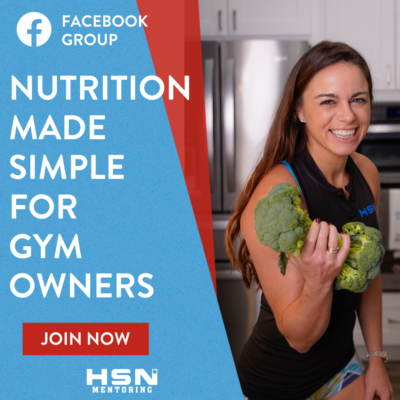
Episode Transcript:
Nicole Aucoin (00:02):
Welcome back to the Grow Your Nutrition Business podcast. At Healthy Steps Nutrition, we believe something as fundamental as nutrition shouldn’t be complicated. We help gym owners and coaches build successful nutrition programs without reinventing the wheel. I’m your host, Nicole Aucoin. Registered dietician and founder of Healthy Steps Nutrition, CrossFit HSN and HSN Mentoring. I’m also the author of the Basics of Nutrition Coaching, CrossFit Preferred Nutrition Course. I’m going to teach you how to take one step at a time to build a successful nutrition program, where you finally feel confident talking about nutrition to your members and your communities. Happy New Year. Every gym owner and coach is looking to capitalize on the fact that people are more motivated around a new year and plan to start a nutrition program.
Nicole Aucoin (00:55):
It makes sense. There are some key things that you need to get a nutrition program off the ground. And today, Ashley and I are talking all about them. These systems are needed to nurture leads, accept payments, and make appointments. That’s right. You need a way to accept payments and make memberships so that you don’t have to hound people to come back every single month. Trust me. I did not have all of these when I started and the struggle was real. We’ll get to this episode on Four Things You Need To Get A Nutrition Program Off The Ground On A Budget right after this message. HSN Mentoring is a turn key solution, to save you time and not reinvent the wheel when it comes to building a nutrition programs from scratch. HSN Mentoring starts with the training process. Which includes online modules, homework, and six one-on-one mentoring calls. The training teaches you how to set up a nutrition program, how to market your nutrition program, how to coach clients using a habit based approach, and most importantly how to retain them.
Nicole Aucoin (02:06):
Lastly, we teach you how to launch a nutrition challenge. Which is a great way to kickstart a nutrition program, but you need a nutrition program to support your clients long after the challenge is over. Getting started with HSN Mentoring is easy. You just need to book a free call with me so that I can learn a little bit more about you. And from there if it’s a good fit, we give you the link to sign up and you go through the training to launch our program in as little as four to six weeks. That’s right. You can add a reoccurring revenue stream within four to six weeks of signing up with HSN. All right. Enjoy this episode on Four Things You Need To Get Your Nutrition Program Off The Ground On A Budget. Ashley Osterman, welcome back to the Grow Your Nutrition Business podcast.
Ashley Osterman (02:54):
Well, thank you, Nicole. It’s always a pleasure to be on here and chat with you about ways that we can help people grow a wildly successful nutrition program. Today, we are talking specifically to those people who have been thinking about starting a nutrition program but are unsure where to start and exactly what you need to get a program off the ground.
Nicole Aucoin (03:17):
Yes. Today, we’re going to talk about four things that you need to get a nutrition program off of the ground and how to do that on a budget. Which is so important, right? If you’re not having any revenue coming in, it’s really tough to invest a lot of money into a program that you don’t yet have money coming in yet.
Ashley Osterman (03:34):
Absolutely. So this is kind of like a do it yourself, DIY version and how to do it without having to spend a lot of money upfront.
Nicole Aucoin (03:42):
All right. So let’s talk about the first thing that you probably need to be able to track progress for clients and be able to help them see those wins. We know that success leads to motivation and we need to be able to show our clients the progress that they’re having.
Ashley Osterman (03:58):
Absolutely. And we always need a place to start. We need a baseline, which is why testing biometrics is so important when you’re starting your nutrition program.
Nicole Aucoin (04:09):
So the first question that usually comes up for me when I’m on free calls or welcome calls with new gyms coming on board. They ask me, “Nicole, do I really need to spend $6,000 on a machine to test body fat percentage? I know you love the InBody, but do you absolutely need this to run a successful nutrition program?” And my answer every time is, “No.” The smart, financial decision is not to invest $6,000 into a machine that you don’t have any revenue coming in yet. Get your program up and running and then reinvest money into a higher quality machine, to give your clients a little bit more data. But InBody does have a home version that a lot of our clients start with and you can get this on Amazon.
Nicole Aucoin (04:53):
We’re going to link the link to the InBody home version in the show notes, so you can grab that. But InBody home version, I think is a really good option for people to test their biometrics so that you can test not only weight, but body fat percentage and muscle mass. Because it’s not just the weight, especially if clients are working out. Right?
Ashley Osterman (05:12):
Right. Absolutely. And Nicole, for those listeners who are wondering like, “What are the big differences between the $6,000 InBody machine versus their home version that you can buy online?”
Nicole Aucoin (05:25):
Yes. So the big difference, and we have the 270 which I love. We had it from when we opened up the gym. It took me a year to convince my husband that we needed it. Looking back, we didn’t necessarily need it and we would have been fine starting with the home version of the InBody. The big difference with those two machines is that you don’t get the printout that you get with the 270. So that $6,000 machine you don’t get that print out.
Ashley Osterman (05:50):
Okay.
Nicole Aucoin (05:50):
But gym’s using our platform are putting all of their client’s biometrics into the app. So you’re tracking their progress there. You don’t necessarily need the [inaudible 00:06:01] because your clients are seeing the trends in graphs in the app.
Ashley Osterman (06:04):
Yeah. I actually super love that option in the app. Any way clients can see that success and see those trends is so important because it really keeps them motivated, and helps them remember their goal and to keep moving forward. So yeah, I guess the big difference you don’t get the print out but it still gives you all of the same biometric data that you would get from the 270 or more expensive version.
Nicole Aucoin (06:27):
Yeah. You don’t get the side by side. So the left side versus right side. But the overall picture you’ll get the same thing. The other thing that we would highly recommend that is less than $5 is a tape measure.
Ashley Osterman (06:39):
Yes. A tape measure. Don’t underestimate the power of measurements.
Nicole Aucoin (06:46):
Inches fall off so much faster than body fat percentage. So if you’re testing your clients’ measurements, you’re going to be able to see those wins much faster than 1% body fat coming off. I want to go back to body fat testing really quick. Because I always get questions about calipers. Right?
Ashley Osterman (07:04):
Oh okay. Yeah. Mm-hmm (affirmative).
Nicole Aucoin (07:06):
And people ask like, “Hey, should I test calibers? I’ve done calibers in the past.” And here’s my problem with calibers is, no one. Not even me. I don’t have a ton of back fat. But no one feels comfortable with you pinching their backpack.
Ashley Osterman (07:21):
Absolutely not.
Nicole Aucoin (07:22):
So the first time you meet someone that is not a really great time to say, “All right. Let’s take your biometrics. Let me pinch you all over the place.” It’s just not comfortable. And the other thing is, is you want to make sure you’re easily able to replicate how you’re testing between coaches.
Ashley Osterman (07:37):
Yes.
Nicole Aucoin (07:37):
And if you’re testing with calibers, the way you test and the way I test is going to be different. The measurement is going to be off. Body fat is going to be different. So, I would recommend having a machine. The other thing that comes up often as gyms might borrow an InBody from a supplement shop or they have a dunk tank come in.
Ashley Osterman (07:56):
Okay. Mm-hmm (affirmative).
Nicole Aucoin (07:58):
But then they have a Omron or Handheld machine for after the challenge is over let’s say.
Ashley Osterman (08:05):
Ooh.
Nicole Aucoin (08:06):
And that’s not consistent.
Ashley Osterman (08:07):
Yeah.
Nicole Aucoin (08:08):
The problem is, is your client’s test body fat percentage with his dunk tank. And then they go to the Omron and it’s not a good comparison. So you need a place to measure body fat in-house, that’s convenient and that you’re not going to have to send your client somewhere else. The InBody home version is a couple of hundred dollars. It’s very reasonable. And then you want to make sure to get that tape measure too so that you can test measurements as well as body fat percentage.
Ashley Osterman (08:33):
Absolutely. Another really great tool as well that doesn’t cost much at all is just doing progress photos. Having those photos, and one of the great options that we have in the HSN app if you’re doing progress photos is you can do the side-by-sides right there in the app and clients can see a visual of progress. Because a lot of times when we’re looking at ourselves in the mirror every day, even though there might be changes, we don’t see it. Right? So to be able to compare photos from when I started to two, three, four months down the road can really help with that motivation to continue on.
Nicole Aucoin (09:04):
Absolutely. We actually interviewed one of our clients that lost 70 pounds on the Nutrition Made Simple podcast. And he sent me a picture before we did the Success Story podcast episode, with his side-by-side and his shirt was literally wrapped around him. And he was so motivated by that side-by-side because he could see all of his hard work paying off, which kept him going. All right. So we understand biometrics. Let’s talk about the next thing, which I always get questions about is scheduling software.
Ashley Osterman (09:39):
Yes.
Nicole Aucoin (09:39):
Why do you need scheduling software?
Ashley Osterman (09:42):
Nicole, if you don’t have a way to be able to schedule your clients, have that follow-up with the information about their appointment and making sure that they are getting alerted for the appointment. You’re not going to have a large rate of people showing up. Because let’s get real. We are in a world where we’re very busy, things happen, you get distracted. So if there’s not an automated way for people to see and be reminded of that appointment, you might not have good show up rate and then less client retention.
Nicole Aucoin (10:14):
Absolutely. So show up rates an important thing that you need for scheduling software, the automated reminders. But then also just logistics and efficiency of a nutrition coach. You don’t want an appointment at 7:00 AM and 7:00 PM. And if you don’t have hours of the month for your nutrition program, it’s going to be really easy for you to say, “Oh yeah. I can see you at seven in the morning.” And then the next client. “Oh yeah. You want to come in for a 2:00 PM appointment. Sure. No problem.” And now you have this huge gap. So, by having hours blocked off and you can just send people a link to book an initial appointment with you, it’s going to be a base around your time not just their time. The other thing is that if, Ashley, let’s say we had a nutrition client sign up our HQ location, they’re going to work with you. I can send them your link. They can book with you. And we don’t have to have that back and forth, which takes days sometimes to get something scheduled.
Ashley Osterman (11:08):
Oh absolutely. It’s more direct, more efficient. And we know that when nutrition coaches can be efficient, they can handle more clients and be able to grow their program.
Nicole Aucoin (11:18):
Absolutely. So you need a scheduling software. Acuity is what we use at our HQ location. I honestly wish I would have invested in this company six, seven, eight years ago because we’ve literally sent hundreds of thousands of people to use this software and we have been talking about it for years. So I love Acuity. I think it’s really awesome. We don’t get a kickback or anything from them. I just think it’s a really good, easy system to use that you can add multiple calendars as your company and your team grows. The next thing I want to talk about, which comes up all the time is how to charge people, what membership software to use and how to keep your clients paying on a monthly basis. So we know that clients that are on a monthly membership for nutrition are going to be retained longer, and you don’t feel like you have to sell them every single month. So you need a way to have reoccurring memberships like a software to have reoccurring membership, so you don’t have to hound clients to sign up again or come in for their followup.
Ashley Osterman (12:20):
Yeah. Absolutely. It’s so important because on that membership subscription, people are just getting ready for the payment to be deducted, right? You’re not having to sell them every time. You’re not having to have another conversation or feel like you need to sell your clients. You can really focus on helping them reach their goals and supporting them. So when it comes to member management, Nicole, is there a specific software that you recommend when people ask?
Nicole Aucoin (12:49):
Yeah. We at our HQ location use PushPress and I love it. We’ve gone through quite a few different softwares over the years since we started in 2012 and hands down PushPress has the best customer service of any software company that I’ve ever been around. And I think part of it is because they were all gym owners, so they understand the frustration of like, “Hey, this is not my specialty. I just need something that’s easy and efficient to use and that it’s not super confusing or complex. And I want to be able to charge my members and I want it to be simple to use really.” So PushPress is awesome. Well, we actually made an integration with them. So you can download the nutrition reporting app from PushPress and it’s easy for you to track your nutrition revenue. So fitness revenue, nutrition only revenue, and then nutrition and fitness revenue. And what I love to see is how much more valuable our nutrition and fitness clients versus fitness only clients. And typically it’s over two times the lifetime value for clients that are nutrition and fitness versus fitness only.
Ashley Osterman (13:55):
Yeah. That’s incredible to see that data for the nutrition program reporting because it’s really just helped so many gym owners and nutrition coaches realize the value, and then invest more time in expanding and growing their programs. And we’ve seen over the last year how successful that has been for them and especially keeping those members engaged during crazy times. So when it comes to PushPress, is this an affordable type of a service, Nicole? What are we looking at there for cost?
Nicole Aucoin (14:22):
Yeah. So PushPress has a free option that I think is really awesome. If you are billing under $10,000 a month, which most nutrition only companies starting up are going to be billing that and some gyms are even billing less than $10,000 a month. That would be a great option. It’s free to use. They charge a little bit more for credit card processing fees, but it doesn’t cost you anything per month. It’s not another monthly subscription that you have to pay for. And PushPress also has a website platform that all of templates are in, so that HSN Mentoring clients who use PushPress can have all of our website templates, what we recommend on their website easily without going back and forth with them a ton. But yeah, PushPress is awesome. They have again, member management. They also have reporting that’s super easy and then they have a website option that you can add on.
Nicole Aucoin (15:12):
So, you need a member of management platform whether it’s using PushPress. We use PushPress plus Stripe. So Stripe is how we charge clients or where the money actually goes that’s billed through PushPress and then it goes straight to our bank account. The other cool thing is we actually had our HQ location switch all of our gym members to ACH, in January of 2020. And it saves us hundreds of dollars every single month on credit card fees, because we don’t have to pay them. It’s ACH instead of it being credit card processing fees every month. Even bigger thing in my opinion is Jason doesn’t have to hound people because their credit cards got declined because they got fraud or whatever and had to get a new card and forgot-
Ashley Osterman (15:57):
Or expired.
Nicole Aucoin (15:57):
Yeah. And forgot to give them to us. So we charge everyone through ACH, which works out really well.
Ashley Osterman (16:03):
Now is ACH just like a direct deposit or debit from their bank account?
Nicole Aucoin (16:06):
Yep. So they give us a-
Ashley Osterman (16:08):
Perfect.
Nicole Aucoin (16:09):
… avoided check. And they can also fill it out once we set up a profile, we can submit a form to them so to fill and then it automatically happens on their own. We don’t have to do anything else with it. Which is easy.
Ashley Osterman (16:19):
Easy. I love it. That’s a great tip.
Nicole Aucoin (16:21):
All right. So now let’s talk about email.
Ashley Osterman (16:23):
Yes. Email.
Nicole Aucoin (16:24):
So I’ve seen so many businesses use their personal email address for their business.
Ashley Osterman (16:31):
Uh-huh. No, no, no, no, no. You need a business email for your business. We have to make the differentiation between your personal and your business email.
Nicole Aucoin (16:42):
Yeah. So at Healthy Steps Nutrition, we have a G-suite of account. G-suite for business account that we use. So our email addresses don’t say @gmail, they say @healthystepsnutrition, but it is technically through Gmail. Through the business. And the cool thing with that is it integrates with everything, right?
Ashley Osterman (17:02):
Oh yeah.
Nicole Aucoin (17:02):
We use Google forms. We use Google sheets, Google documents, and we use all things Google.
Ashley Osterman (17:07):
Google shared drive, everything. It’s all Google.
Nicole Aucoin (17:10):
Everything. So, creating a Google business account would be really smart to do. And then the cool thing, which if you don’t have a website you could start off with a Google form to capture lead information, and have people apply for nutrition coaching, follow up with them from a Google form.
Ashley Osterman (17:28):
So when you say using a Google form to capture leads before having a website, so what would you have potential clients put into that Google form?
Nicole Aucoin (17:36):
Yeah. So their name, first name, last name, their email address, their phone number. I have a checkbox that’s nutrition, fitness, both. What are people looking for? What are their goals and then how committed are they? I like to write like, “What are you looking for? What does success look like for you?” So that we can have an idea before Jason or whoever calls them, calls up the lead and follows up with them to then guide them to sign up for our program. So, we found that applying for nutrition coaching through that Google form actually gave us more leads than people booking free enters right off of our website. I think it’s just a little bit less intimidating for people to fill out a form to get some more information.
Ashley Osterman (18:20):
Yeah. Instead of just being contacted right away. You can get a little more information from them. They can feel like they’re sharing a little bit with you. And then you kind of start that relationship before a cold call or something like that.
Nicole Aucoin (18:31):
And from there, what we do is we have these email addresses and then we put them into automation campaigns through MailChimp. And that’s free up to 10,000 emails, which is awesome. So you can email people regularly so that they’re seeing information and free help coming from you on a consistent basis. And if I could say that, what one thing has helped us move the needle forward with any of the businesses that we’ve started. It is staying in consistent contact with people who were once interested in our program. And we did that all through MailChimp to start. I mean, it’s super easy. Again, so instead of four things, I would add MailChimp as the number five, so that you can stay in contact and provide free help to your clients regularly.
Nicole Aucoin (19:19):
One of the things that we do at HSN is we actually give the gym owners and coaches all of the content to send out, a video script and an email to send out every single week. So people are seeing nutrition help coming from you. And when they’re ready, they’re more likely to come to you because you’ve already started building that relation.
Ashley Osterman (19:37):
Yeah. Nicole, I think that’s one of the biggest mistakes that people make when trying to get their nutrition program off the ground is not being consistent with that free help. Not consistently showing that you are the expert and you are there to help them when they’re ready. Because if you have those leads, it doesn’t mean much until they realize that they can associate you with helping their problem. And you have to be able to do that on a consistent basis for them to remember. Right?
Nicole Aucoin (20:01):
Absolutely. One of the things that you and I, because you are really the head. You and Melinda are the head of creating a lot of the content for HSN, for the gyms that are using it. One of the things we talked about was, let’s make the video scripts align with the email so that people can make the video and then embed that video into the email that goes out. So whether you are a person that likes to read or a person that likes to watch video, you can capture that client’s attention or that lead’s attention and build that relationship with them. I know one thing that we found at our HQ location as well as with the mentoring program. When I send out video content and they nurture people with video content, people come to free calls or they sign up because they’re like, “I feel like I already know you.”
Ashley Osterman (20:50):
Yep.
Nicole Aucoin (20:50):
I feel like you’ve already helped me. And you can do that so much better through video than just writing words in an email.
Ashley Osterman (20:59):
Absolutely. And people hear and learn things differently. So to have the same message out in different ways on different platforms is such a good strategy for people to remember. They can come to you when they’re ready to make that change and they need that help.
Nicole Aucoin (21:15):
Absolutely. You have to say things so many times for people to take action. So you make this video, you put it on your social media, you send it out an email content, you put it on your blog. You’ve got it all these different places where wherever people are, they can find you and they can see all this free help. You don’t have to come out with a million ideas every month. Use the same idea and say things different ways so that people can take action. Say the most important things, different ways.
Ashley Osterman (21:41):
Absolutely. Well, another thing I want to mention about Gmail. If you’re not using like an automation system like MailChimp or something like that, you can also do templates in Gmail. So you can have template emails for different topics and you can have those saved, so whenever somebody signs up, whenever somebody is booking a call or whenever you’re sending out specific information you have those saved in template form in Gmail. And another thing too is you can schedule out your emails in Gmail as well, too. So really great to know, to have that if you’re using that for your business.
Nicole Aucoin (22:13):
Love it. So let’s just recap here. We need something to task biometrics. I would, if you’re on a budget, tape measure, a hundred percent. InBody home version is a really good option. We need a way to schedule our clients. Acuity Scheduling is a really good software. Again, we don’t get a kick back for any of these companies. So do as you wish. Member management software. So this is a way to have that reoccurring revenue from nutrition, set up similar to a gym membership. PushPress has a free option that’s awesome. They also have a paid option. Love everyone at PushPress. I think they’re very, very great. And then you need an email. So an email system, I would recommend Gmail for sure. G suite for businesses is really awesome. For those of you who are listening to this podcast and you’re thinking, “Oh my goodness, there’s so much stuff. I’m unsure where to start.” We have a ton of free help on the website to get you started.
Nicole Aucoin (23:11):
So, click the link in the show notes and head over to our website so that you can get all this free help to save you time so that you do not have to reinvent the wheel. Well, as nutrition coaches and gym owners we have a huge opportunity to empower people to become the healthiest versions of themselves. And you have to have the systems in place to be able to help more people. So, head over to link in the show notes and grab all of the free help that’s available from HSN Mentoring today.
Nicole Aucoin (23:48):
I hope you enjoyed that episode on Four Things You Need To Get Your Nutrition Program Off The Ground On A Budget. If you are listening to this thinking, “I’m a little bit behind. I want to launch a nutrition program. I want to support my clients. I have no idea where to start.” I’ve created an awesome resource for you. We’ve consolidated everything you need to get a nutrition program off the ground, and all of the podcasts related to starting a nutrition program in the show notes. So, click the link in the show notes and you can access everything in one place. But before you go, did you enjoy this episode? Make sure you subscribe so you don’t miss another episode again. Until next time.

